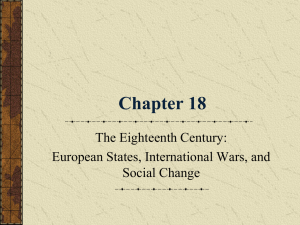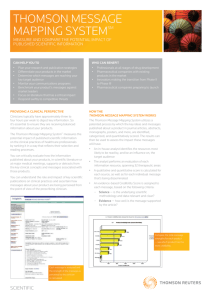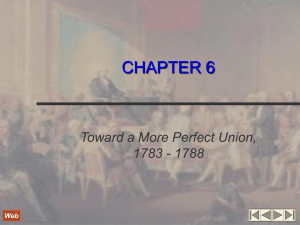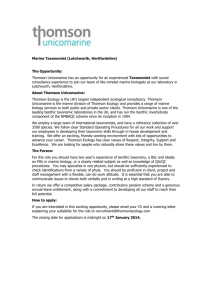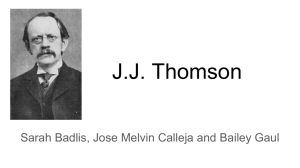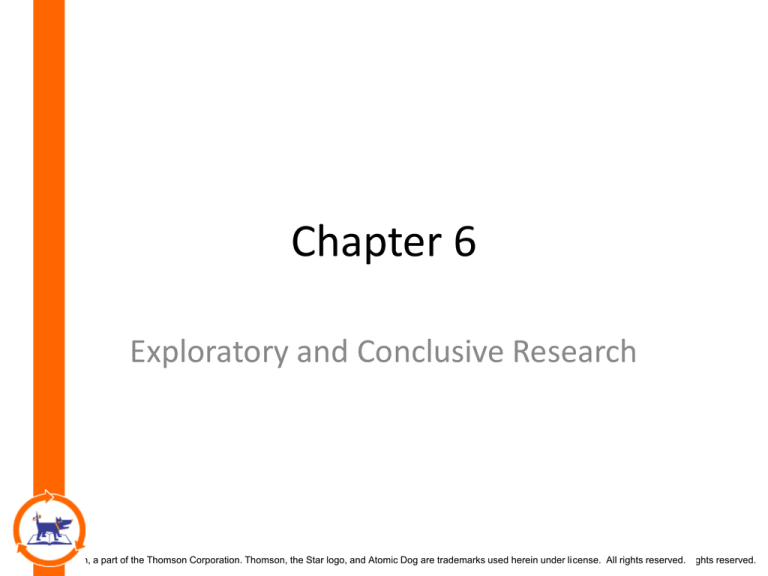
Chapter 6
Exploratory and Conclusive Research
© 2008 Thomson,
© a2008
part Thomson,
of the Thomson
a part Corporation.
of the Thomson
Thomson,
Corporation.
the Star
Thomson,
logo, and
the
Atomic
Star logo,
Dog and
are trademarks
Atomic Dogused
are trademarks
herein under
used
license.
hereinAll
under
rights
license.
reserved.
All rights reserved.
Qualitative Research Defined
Exploratory research involves collecting information in
order to provide insight into problem and identify
courses of action. Research findings are not subject to
quantitative analysis.
• sources:
– secondary data
– focus group
– in-depth interviews
• depends on uncertainty & acceptable risk level
– crucial decisions require both more information
and more accurate information
– low-risk decision options may not require
conclusive research
© 2008 Thomson, a part of the Thomson Corporation. Thomson, the Star logo, and Atomic Dog are trademarks used herein under license. All rights reserved.
Quantitative Research
• Descriptive in nature.
• Enables marketers to “predict” consumer
behavior.
• Research methods include experiments,
and survey techniques.
• Findings are empirical.
© 2008 Thomson, a part of the Thomson Corporation. Thomson, the Star logo, and Atomic Dog are trademarks used herein under license. All rights reserved.
Qualitative vs. Quantitative Research
Comparison Dimension Qualitative Research
Quantitative Research
Types of questions
Probing
It depends
Sample size
Small
Large
Information per
respondent
Rich
Not as detailed
Types of analysis
Ability to replicate
Subjective,
Interpretive
Low
Statistical,
Summarization
High
© 2008 Thomson, a part of the Thomson Corporation. Thomson, the Star logo, and Atomic Dog are trademarks used herein under license. All rights reserved.
Pros/Cons of Qualitative Research
• Cheaper option than quantitative research.
• Very useful to uncover hidden feelings and
motivations.
• Usually used as a precursor to quantitative
research.
• Small number problems.
• Generalizability problems.
© 2008 Thomson, a part of the Thomson Corporation. Thomson, the Star logo, and Atomic Dog are trademarks used herein under license. All rights reserved.
Focus Groups
• What are Focus Groups?
• Steps in Conducting a Focus Group
1. Focus Group Facility; Recruit the participants
2. Select a Moderator
• Skills required
• Discussion Guide
3. The Actual Focus Group
4. Report Generation
© 2008 Thomson, a part of the Thomson Corporation. Thomson, the Star logo, and Atomic Dog are trademarks used herein under license. All rights reserved.
Advantages of Focus Groups
• Lower cost
• Possible stimulating effects from interaction &
group dynamics among respondents
• The opportunity to observe customers from
behind one-way mirrors
• Quickness of execution
© 2008 Thomson, a part of the Thomson Corporation. Thomson, the Star logo, and Atomic Dog are trademarks used herein under license. All rights reserved.
Disadvantages of Focus Groups
• Inductive approach
• Faulty focus group setting / recruiting may
lead to a lot of problems
– Generalizability issues
– Ambience
– Dominance
• “Moderator style” may contribute to
respondent bias.
© 2008 Thomson, a part of the Thomson Corporation. Thomson, the Star logo, and Atomic Dog are trademarks used herein under license. All rights reserved.
Good uses of Focus Groups
• Concept testing
• How do consumers use a product?
• Good source of ideas about product
improvements
• Exploring problems
• Why do consumers behave the way they do?
• What issues to cover in a descriptive or a causal
study?
• TRENDS
© 2008 Thomson, a part of the Thomson Corporation. Thomson, the Star logo, and Atomic Dog are trademarks used herein under license. All rights reserved.
Group design
• Group design issues:
– homogeneity of group
– size & duration - generally 8 to 12 people for 1 to 2
hours
– screening of participants
– number of sessions
– relaxed environment
– cost
– moderator - need skills to build respondent rapport
© 2008 Thomson, a part of the Thomson Corporation. Thomson, the Star logo, and Atomic Dog are trademarks used herein under license. All rights reserved.
Choosing a Moderator
• consider gender, whether same moderator should lead multiple
sessions, and necessary skill set:
–
–
–
–
–
–
–
–
combination of empathy and firmness
permissiveness
encourages involvement
conveys incomplete understanding
flexibility
sensitivity
knowledge of subject
creativity
• moderator's guide provides a detailed outline of the issues to be
discussed and serves as a memory aid for the moderator
© 2008 Thomson, a part of the Thomson Corporation. Thomson, the Star logo, and Atomic Dog are trademarks used herein under license. All rights reserved.
Analyzing Focus Groups
(Report generation)
• Step 1. review the research purpose
• Step 2. study the group discussions
• Step 3. create categories
– demographic profile of respondent base, respondent profile, classification
of comments
• Step 4. identify potential relationships
• Step 5. write report
–
–
–
–
–
executive summary
research purpose
methodology
results, identified hypothesis, implications for further study
appendix
© 2008 Thomson, a part of the Thomson Corporation. Thomson, the Star logo, and Atomic Dog are trademarks used herein under license. All rights reserved.
Depth Interview
• uses extensive probing to get a single respondent to
freely express detailed beliefs and feelings
• Advantages:
– useful when questions are sensitive or potentially
embarrassing
– greater depth of insight that can be uncovered
– ability to associate the response directly with the
respondent
– higher level of rapport possible
© 2008 Thomson, a part of the Thomson Corporation. Thomson, the Star logo, and Atomic Dog are trademarks used herein under license. All rights reserved.
Depth Interview
• Disadvantages:
– complete reliance on the interviewer
– difficult to average results across different
interviewers
– enormously demanding and time-consuming
– few highly qualified interviewers at high cost
– small sample size
– costly
© 2008 Thomson, a part of the Thomson Corporation. Thomson, the Star logo, and Atomic Dog are trademarks used herein under license. All rights reserved.
Depth Interviews
• Typically lasts 1-2 hours
• Tips for in-depth interviews:
• Be flexible
• Don’t interrupt
• Be silent: Real needs start surfacing under
silence
Flavored chip
Strong taste
Eat less
Better figure
Self-esteem
© 2008 Thomson, a part of the Thomson Corporation. Thomson, the Star logo, and Atomic Dog are trademarks used herein under license. All rights reserved.
Good Uses of Depth Interviews
– Why do consumers use a product in a particular
way?
– Sometimes give the marketers a better feel for
customers’ lives
– Underlying bases can be identified easily
– First step in developing a questionnaire
© 2008 Thomson, a part of the Thomson Corporation. Thomson, the Star logo, and Atomic Dog are trademarks used herein under license. All rights reserved.
Group Vs Individual Interview
-The distinguishing feature of the
group is its “groupness”
-Does this add to the data via the
operation of group dynamics?
-Does this contaminate the data
via group dynamics?
© 2008 Thomson, a part of the Thomson Corporation. Thomson, the Star logo, and Atomic Dog are trademarks used herein under license. All rights reserved.
Quantitative Techniques for Conclusive
Research
Conclusive research involves a systematic and
objective process through which a target market is
sampled and responses are measured.
• results statistically and scientifically valid, to
support predictions
• types of data sought:
– past behavior – may gather evidence on past behavior
for the purpose of predicting future behavior
– attitudinal data – may identify the nature of attitudes,
measure them, and connect attitudes and eventual
behavior statistically
– respondent characteristics
© 2008 Thomson, a part of the Thomson Corporation. Thomson, the Star logo, and Atomic Dog are trademarks used herein under license. All rights reserved.
6-3c Respondent Characteristics
• variables known to correlate well with eventual purchase behavior
– demographics
– socioeconomic variables
– psychological variables
• variables useful in sample stratification and validation
–
–
–
–
–
–
–
age
gender
marital status
family size
income
occupation
education level
© 2008 Thomson, a part of the Thomson Corporation. Thomson, the Star logo, and Atomic Dog are trademarks used herein under license. All rights reserved.
6-4 Methods of Collecting Respondent
Data
• communication method – direct questioning of respondents through
questionnaire
–
–
–
–
personal (face-to-face) interview
telephone interview
mail interview
internet-based interview
• observation method – recording behavior
–
–
–
–
–
natural vs. contrived environment
disguised vs. undisguised – aware of observation?
structured vs. unstructured – defined set of behaviors?
direct vs. indirect – behavior itself or indicator of past behavior
human vs. mechanical observation
© 2008 Thomson, a part of the Thomson Corporation. Thomson, the Star logo, and Atomic Dog are trademarks used herein under license. All rights reserved.
6-4b Personal Interview
• interviewer asks questions of one or more respondents in a
face-to-face situation and records the responses
• advantages:
– better rapport with respondent – can be freer with responses
– more adaptable to respondent
• disadvantages:
–
–
–
–
costly
time consuming
participants less free with responses on sensitive issues
may bias responses
© 2008 Thomson, a part of the Thomson Corporation. Thomson, the Star logo, and Atomic Dog are trademarks used herein under license. All rights reserved.
6-4c Telephone Interview
• interviewer asks questions over the phone and records the responses
• advantages:
–
–
–
–
efficient and economical procedures
application to a wide range of information needs
scalability if project expands
reduced potential for bias compared with face-to-face
• disadvantages:
–
–
–
–
limited amount of data obtainable
impossibility of accurately recording non-verbal information
potential bias from incomplete listing of target population
shorter interview possible relative to face-to-face
© 2008 Thomson, a part of the Thomson Corporation. Thomson, the Star logo, and Atomic Dog are trademarks used herein under license. All rights reserved.
6-4d Mail Interview
• questionnaire sent by post and completed questionnaire is returned by
mail to the research organization
• advantages:
–
–
–
–
respondent can take time in responding to questions
flexible in application
relatively low in cost if response rates are high
less potential for bias than face-to-face
• disadvantage: nonresponse error
– difficult to ensure that some specified number of total responses is
received
– impossible to ensure that those who return the questionnaire are
representative of the sample or population of interest
© 2008 Thomson, a part of the Thomson Corporation. Thomson, the Star logo, and Atomic Dog are trademarks used herein under license. All rights reserved.
6-4e Internet-based Methods
•
advantages:
–
–
–
–
•
respondent can take time in responding to questions
branching prevents exposure to irrelevant questions
flexibility of question rotation (counterbalancing)
compilation of responses is automatic
disadvantage:
– selection for internet access could result in sampling error
•
preferable when:
–
–
–
–
–
–
convenience sample is adequate
email addresses of target population are known
sample size large enough to justify the higher start-up costs
dealing with highly sensitive issues
employing many open-ended questions
survey includes digital interactive elements
© 2008 Thomson, a part of the Thomson Corporation. Thomson, the Star logo, and Atomic Dog are trademarks used herein under license. All rights reserved.
6-4f Criteria for Selecting the
Communication Approach
telephone
mail
web
versatility*
cost
speed
sample control
quantity of data
quality of data on
sensitive issues
clarity
face-to-face
general preferability (ranked)
1
3
4
1
2
2
2
3
3
4
3
1
2
2
3
2
1
4
1
4
1
3
2
2
3
1
3
* exception: mail and web allow the respondent total flexibility as to when and where the
interview takes place
web costs more up-front but can save funds in interviewing and data input
© 2008 Thomson, a part of the Thomson Corporation. Thomson, the Star logo, and Atomic Dog are trademarks used herein under license. All rights reserved.
6-4f Criteria for Selecting the
Communication Approach (cont.)
• response rate
• methods for estimating nonresponse error:
– sensitivity analysis – how different is each successive callback
group is from the previous respondent group?
– trend projection – if a trend develops on the variables of
interest during successive callbacks, it can be used to
estimate the characteristics of the nonrespondent group
– subsample measurement – a specially designed interview is
used to estimate the results of the nonrespondent group
– subjective estimate – researcher uses experience and
judgment to estimate the degree of nonresponse error
© 2008 Thomson, a part of the Thomson Corporation. Thomson, the Star logo, and Atomic Dog are trademarks used herein under license. All rights reserved.


